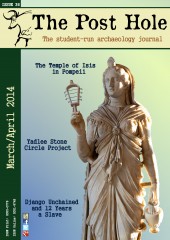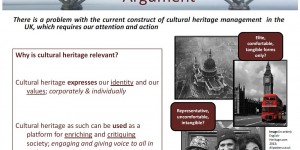Django Unchained was released in the UK on the 18th January 2013, around the same time I began my third year module ‘Archaeology of the Modern World’. It offered the chance to further my understanding of the transatlantic slave trade – a subject which I was particularly interested in, having worked at Harewood House since the age of sixteen, and learnt little from secondary education. After completing third year, I sat down to watch Django Unchained, fully expecting to enjoy the film which came highly recommended. However, I got so angry at aspects of the film that I had turned it off within an hour. I then chanced upon Izaak Wilson’s (2013) article ‘Can Django Speak? New archaeologies of slavery’ which asked to what extent archaeology could give a voice to those subjected to slavery and offered a theoretical basis by which this might best be achieved. The author praised the film, calling it an intervention (Wilson 2013, 27, 35). “In some ways the film was more interesting than the most intense documentaries, the artistic license allowing the makers to go beyond the strictures of the Just-So story and play about with the idea that a black slave might actually have done something extraordinary. We saw a vision of freedom that […] went beyond the norm of a slave merely observing their lot in life.” (Wilson 2013, 35). By Just-So story, I presume the author is referring to the strictures of non-fictional historical narrative, rather than the Just-So stories of authors such as Rudyard Kipling. This leaves the implication that historical narratives rarely, if ever, portray an enslaved African doing anything extraordinary, an assertion that is also implicit in Tarantino’s interview with Krishnan Guru-Murphy on Channel 4 News (2013).
I recently watched Steve McQueen’s (2013) film ‘12 Years a Slave’, an adaptation of the historical narrative written by Solomon Northup in 1853. The release of the film provided the opportunity to revisit Django Unchained (which I have now watched in its entirety) and to attempt to articulate what is wrong with the film and Tarantino’s own marketing of it – he himself describes the film as an intervention (Channel 4 News, 2013). The following discussion of the films Django Unchained and 12 Years a Slave raises pertinent questions about the UK’s failure to confront its own significant role in transatlantic slavery and its colonial past. It also argues that this failure has resulted in many of the tensions which exist within, and between, communities in the UK today.
Like Inglorious Basterds (2009), Django Unchained is a remake, based on Sergio Corbucci’s (1966) Italian take on the Spaghetti Western, Django. In the 1966 film, the eponymous hero is a former Union soldier who exacts vengeance for the murder of his wife by a gang of racist Confederates who have taken over his hometown. The film can be attributed to the exploitation genre – low budget films which rely on the exploitation of lurid subject matter, often action, sex and/or violence to gain financial success (Wikipedia). Django Unchained is also heavily influenced by Mandingo (1975), a film which exploits sex and violence in the form of Mandingo fighting, whereby enslaved Africans are forced to fight each other to the death. Mandingo fighting is central to the story of Django Unchained; in one memorable scene an enslaved African is handed a hammer by Calvin Candie (Leonardo DiCaprio), a slave-owner and Mandingo fight enthusiast, with which to ‘finish-off’ his opponent. It is important to note that Mandingo fighting only exists in the popular imagination: there is no evidence for such a practice in the historical record beyond rumours of isolated incidents, and particularly not on the scale shown in Django Unchained and Mandingo, in which it is depicted as sport (Harris 2012).
There is no doubt that Tarantino is heavily influenced by the exploitation genre into which Django Unchained does fit. Like most of Tarantino’s films, it exploits violence, which is visually quite subdued by Tarantino’s standards when depicting atrocities against the enslaved, but which reverts to the ‘cathartic’ hyper-violence with which the director has become synonymous when depicting violence against whites (and horses). The film could even be said to exploit history itself, which, as in Inglorious Basterds, provides the stage on which these tales of comic-book style revenge are carried out. So, as an exploitation film which bears more in common with a cartoon or comic than any historical reality, the film can be accepted, though it has been convincingly argued by Jean Celestin in the Haitian Times (2012) that the film is disrespectful because, unlike Inglorious Basterds, it deals with a subject that has yet to be portrayed sensibly by mainstream Hollywood (i.e. Schindlers List, The Pianist etc.). A problem does, however, arise when Tarantino states “I am responsible for people talking about slavery in a way that they have not for 30 years…there is actually a dialogue going on about slavery right now that has not been happening, at all. It’s a subject that people are afraid to talk about, and now because of this movie, people aren’t afraid to talk about it, people are talking about it…there is brutality to the slaves that hasn’t been dealt with in America to the extent that I deal with it and I’m showing you that there were two holocausts in America, this is one of them, we’ve dealt with the Indian holocaust.” (Channel 4 News 2013).
Tarantino’s assertion that the film is an exploration of slavery (i.e. the realities of slavery) blurs the line between fact and fiction as represented within the film, thereby presenting Mandingo fighting as historical fact. Popular misconceptions about slavery in the US are reinforced by scenes such as the one in which Dr. King Schultz (Christoph Waltz) tells the enslaved Africans freed with Django: “Or…you could unshackle yourselves. Take a rifle. Put a bullet in his head. Bury him deep and make your way to a more enlightened area of this country. Choice is yours. Oh, and on the off chance there are any astronomy aficionados amongst you, the North Star is that one.” (Django Unchained 2012). The southern states have long been scapegoated within American popular culture for the atrocity of chattel slavery in the US. However, slavery was highly significant in the northern states too, a fact subverted by every film in which the racists all have southern accents, including Django Unchained where the only northerner represented in the film is wholly untouched by the dominant racist ideologies of the period, or even abolitionist discourses which portrayed the enslaved as unsophisticated, persecuted victims wholly reliant on Christian goodwill in order to gain public support (Chater 2009, 165). Tarantino states that the film’s raison d'être was to provide black American males with an empowering “Western hero” (Channel 4 News 2013). It has to be questioned just how empowering the film is, when throughout Django is reliant on the jarring paternalism of Dr. Schultz. Celestin (2012) describes this relationship as follows: “There’s nothing self-determining or redeeming about Django becoming who he becomes as a result of this white saviour phenomenon.” This film simply cannot be described as an ‘exploration of slavery’ because it is reliant on elements which taken individually are implausible, but combine to make a story that says more about white popular culture than the horrors of chattel slavery.
The transatlantic slave trade is a subject that has yet to be properly addressed in either the US or UK. This is highlighted by a comment made by Simon Mayo at the end of Mark Kermode’s Radio 5 Live review of Django Unchained: “There was a point after about ninety minutes where I found myself thinking, I really, really hope that Quentin Tarantino never feels as though he has to make a film about Northern Ireland, or Syria, or something that, you know, that matters or has some contemporary relevance” (BBC Radio 5 Live 2013). From discussions with friends, family, workmates etc. (the majority of whom are white), it has become clear to me that the view that the transatlantic slave trade has no contemporary relevance is widely held. The reason that transatlantic slavery, and by extension, the implications of British colonialism, are thought to have no contemporary relevance in the UK, is because certain links are not being made by those with the responsibility of educating people about them (i.e. the BBC, the Department for Education, Harewood House Trust etc.).
These links are well illustrated by the history of the Lascelles, the aristocratic family who reside at Harewood House, Yorkshire. The Lascelles were instrumental in shaping Britain as a colonial power. The family owned more than 27,000 acres of land in Jamaica, Tobago, Barbados and Granada, as well as having interests in ships that traded enslaved Africans between Africa and Barbados (Lascelles Slavery Archive). The Lascelles family received compensation of £26,309, equivalent to over £20 million in today’s terms, from the British Treasury for the release of approximately eight hundred enslaved Africans they owned (calculated from figures in The Independent 2013).
Henry Lascelles (1690-1753) was also director of the East India Company between 1737 and 1745 (Wikipedia), a private company which would go on to colonise and exploit the Indian sub-continent up until the Indian Rebellion of 1857, and has been described as the progenitor of the modern multi-national (Robins 2012). The profits derived from slave-trading, ownership, and colonial expansion allowed Henry Lascelles to purchase the manor of Gawthorpe in 1739, thereby buying into the English aristocracy (Smith 2006). A cluster of streets in Harehills, a neighbourhood in north Leeds, take their names from the Lascelles family who owned the surrounding land prior to development. That these streets, and indeed the entire neighbourhood, are now inhabited in a large part by families from India, Pakistan and Bangladesh, highlights a forgotten link between the histories of these families and that of the Lascelles. The Lascelles’ fortune, which is still very much in existence, was founded on the exploitation of the ancestors of people who now live just a few miles down Harrogate Road from Harewood (i.e. Chapeltown and Harehills). These communities are still economically poor whilst the Lascelles, and other members of the white British establishment who profited directly from the transatlantic slave trade and other forms of British colonialism, are rich. The Lascelles only sold their final plantation in the Caribbean in 1975 (Webb 2007).
The transatlantic slave trade provided the surpluses of capital and export markets which drove eighteenth-century colonial expansion, and provided the foundation for the expansion of the British Empire (Inikori 2002). Georgie Wemyss’ (2009) book The Invisible Empire: White Discourse, Tolerance and Belonging demonstrates how dominant liberal discourse in the UK manipulates historical narratives to avoid confronting the implications of Britain’s colonial past. This past provides an explanation as to why Britain is now home to people from Britain’s former colonial possessions (i.e. Jamaica, Kenya, Bangladesh, India), but it is a past which people in Britain are largely ignorant of. Wemyss’ (2009) book includes a quote from a young Bangladeshi male living in Tower Hamlets, east London, condemning the BNP’s deportation policy. He contextualised his argument as follows: “They are ignoring the fact that what Britain is today, is a lot of blood and sweat from the people of Bangladesh, India, Africa, and other countries, not only in this country, but in colonial times, in India and Africa. All the wealth was coming from all over the world…and then after the Second World War there was a crisis of labour and people were invited to rebuild this country and produce goods to sell to the Third World again…so they are making a double profit…Britain, what it is today, is due to hundreds of years of colonialism.” (Wemyss 2009, 138). The profit derived from the British Empire was concentrated in the pockets of a very small number of people, the majority of Britons enduring low wages, dangerous working conditions, and the loss of ancient common rights to land through Parliamentary Acts of Enclosure (for the latter see Neeson 1993). Slavery did not go uncontested in Britain. In 1788, two-thirds of the adult male population of Manchester signed a petition demanding the abolition of the slave trade (Colley 1996, cited in Wemyss 2009).
Steve McQueen’s film 12 Years a Slave (2013) tells the story of Solomon Northup, a free African-American who is kidnapped and sold into the southern slave economy. The film and the performances within it are incredible, moving a person sat behind me in the cinema to tears by the end of it. The film is a success because it is nuanced, offering an insight into the contradictions inherent within the chattel slavery. For example, Edwin Epps (Michael Fassbender) is a slave owner whose love for Patsy, an enslaved African, clashes against the racist ideology embedded within him and the society as a whole, driving the character to acts of horrible violence. Further, it is a success because it is a black director’s depiction of the experience of an African-American who experienced chattel slavery first hand, who then went on to publish a best-selling book about his experiences, and who subsequently became active in the Underground Railroad and abolitionist movements. All of this featured in a Culture Show Special Steve McQueen: Are you sitting comfortably?, which was dedicated to the film, its background, and to the artist-turned-director, Steve McQueen.
Both Django Unchained (2012) and 12 years a Slave (2013) deal with subject matter that is seen by many in the UK to have little contemporary relevance, with the wider implication being that our colonial past has little contemporary relevance. Both Chiwitel Ejiofor, the film’s lead actor, and McQueen have recently been leading calls for Northup’s (1853) book to be included in the school curriculum and for Britain to properly confront its colonial past (The Bath Chronicle 2014). The current Secretary of State for Education, Michael Gove MP, was formerly chair of the right-wing think tank ‘Policy Exchange’, which has argued that history lessons should focus on the positive aspects of colonialism, rather than “focusing attention on the racism and violence of Empire,” (Mirza et al. 2006, 92) in order to promote a more coherent ‘British identity’ (Wemyss 2009, 175). Michael Gove MP serves under Prime Minister David Cameron, whose family, like the Lascelles, were compensated for the loss of their enslaved African property (The Independent 2013). Since teaching of the transatlantic slave trade only became a compulsory part of the secondary school curriculum in 2008, it should be questioned in whose interests the dominant discourse acts by failing to teach about Britain’s colonial past.
Bibliography
- Celestin, J. M. (2012) ‘Django Unchained: Hollywood Belittles Slavery to Make a Slick Flick’, Haitian Times, 31st December, Available at: http://www.haitiantimes.com/django-unchained-slavery-hollywood/ [Accessed: 13th February 2014].
- Channel 4 news (2013) Television programme, Channel 4, Available at: http://www.youtube.com/watch?v=GrsJDy8VjZk [Accessed: 9th February 2014].
- Colley, L. (1996) Britons: Forging the Nation 1707-1837, Vintage: London.
- Chater, K. (2009) Untold Histories: Black people in England and Wales during the period of the British slave trade, c. 1660-1807, Manchester University Press: Manchester.
- Django Unchained (2012) Film, Directed by Steve McQueen, The Weinstein Company and Columbia Pictures: USA.
- Harris, A. (2012) ‘Was There Really “Mandingo Fighting,” Like in Django Unchained’, Slate, 24th December, Available at: http://www.slate.com/blogs/browbeat/2012/12/24/django_unchained_mandingo... [Accessed: 13th February 2014].
- Inikori, J. E. (2002) Africans and the Industrial Revolution in England: A Study in International Trade and Developent, Cambridge University Press: New York.
- Kermode and Mayo’s Film Review (2013) Radio program, Radio 5 Live, Manchester, 18th January 2013, Available at: http://www.youtube.com/watch?v=NAAGzq-SLq4 [Accessed: 12th February 2014].
- Lascelles Slavery Archive, Available at: http://www.york.ac.uk/projects/harewoodslavery/about.html [Accessed: 15th February 2014].
- Manning, S. (2013) ‘Britain’s colonial shame: Slave-owners given huge payouts after abolition’, The Independent, 24th February 2014, Available at: http://www.independent.co.uk/news/uk/home-news/britains-colonial-shame-s... [Accessed: 13th February 2014].
- Mirza, M. Senthilkamaran, A. and Ja’far, Z. (2006) Living Apart Together: British Muslims and the paradoxes of multiculturalism, Policy Exchange.
- Neeson, J. M. (1993) Commoners: Common right, enclosure and social change in England, 1700-1820, Cambridge University Press: Cambridge.
- Northup, S. (1853) Twelve Years a Slave : Narrative of Solomon Northup, a Citizen of New York, Kidnapped in Washington City in 1841, and Rescued In 1853, Derby and Miller: New York.
- Robins, N. (2012) The Corporation that Changed the World: How the East India Company Shaped the Modern Multinational, 2nd edn. Pluto Press: London.
- Smith, S.D. (2006) Slavery, Family, and Gentry Capitalism in the British Atlantic: the world of the Lascelles 1648-1834, Cambridge University Press: Cambridge.
- Steve McQueen: Are you sitting comfortably?: A Culture Show Special (2013) Television programme, BBC Two.
- Webb, C. C. (2007) Conserving and Making Available the Records of Slavery, University of York, Available at: http://www.york.ac.uk/media/library/documents/borthwick/projects/7Lascel... [Accessed: 14th February 2014].
- Wemyss, G. (2009) The Invisible Empire: White Discourse, Tolerance and Belonging, Ashgate Publishing Limited: Farnham.
- Wikipedia, Available at: http://en.wikipedia.org/wiki/Henry_Lascelles_(1690-1753) [Accessed: 14th February 2014].
- Wikipedia, Available at: http://en.wikipedia.org/wiki/Exploitation_film [Accessed: 14th February 2014].
- Wilson, I. (2013) ‘Can Django Speak? New archaeologies of slavery’, The Posthole, 27, pp. 29-35.







